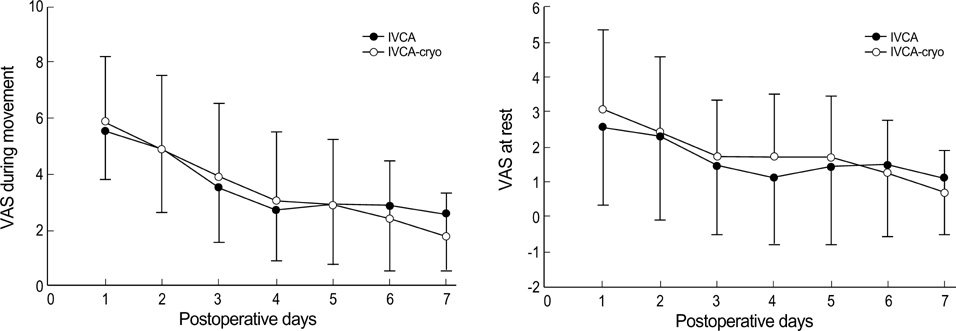J Korean Med Sci.
2004 Feb;19(1):74-78. 10.3346/jkms.2004.19.1.74.
Effect of Cryoanalgesia Combined with Intravenous Continuous Analgesia in Thoracotomy Patients
- Affiliations
-
- 1Department of Anesthesiology and Pain Medicine, Samsung Medical Center, Sungkyunkwan University School of Medicine, Seoul, Korea. mkyang@smc.samsung.co.kr
- KMID: 1785697
- DOI: http://doi.org/10.3346/jkms.2004.19.1.74
Abstract
- Fifty patients undergoing thoracotomy was studied to compare the effects of cryoanalgesia combined with intravenous continuous analgesia (IVCA). Patients were randomized into two groups: IVCA group and IVCA-cryo group. Subjective pain intensity was assessed on a visual analogue scale at rest (VAS-R) and during movement (VAS-M). Analgesic requirements were evaluated over the 7 days following surgery. Forced vital capacity (FVC) and forced expiratory volume in 1 sec (FEV1) were measured before operation, on the 2nd and 7th postoperative days (POD). We interviewed patients by telephone to evaluate the prevalence of post-thoracotomy pain at the 1st, 3rd, and 6th months postoperatively. No significant differences were observed between the two groups with respect to postoperative pain, analgesic requirements, side effects, respiratory complications, or prevalence of post-thoracotomy pain. However, a significant increase in FVC and FEV1 was observed on the 7th POD in IVCAcryo group. The incidence of the post-thoracotomy pain at the 1st, 3rd, and 6th months postoperatively was 68, 60, and 44% in IVCA group, and 88, 68, and 28% in IVCAcryo group, respectively. Our study showed that cryoanalgesia combined with IVCA effectively restore respiratory function on 7th POD, but that it was not effective at reducing the incidence of post-thoracotomy pain.
Keyword
MeSH Terms
Figure
Reference
-
1. Sabanathan S, Eng J, Mearns AJ. Alterations in respiratory mechanics following thoracotomy. J R Coll Surg Edinb. 1990. 35:144–150.2. Richardson J, Sabanathan S, Shah R. Post-thoracotomy spirometric lung function: the effect of analgesia. A review. J Cardiovasc Surg. 1999. 40:445–456.3. Brichon PY, Pison C, Chaffanjon P, Fayot P, Buchberger M, Neron L, Bocca A, Verdier J, Sarrazin R. Comparison of epidural analgesia and cryoanalgesia in thoracic surgery. Eur J Cardiothorac Surg. 1994. 8:482–486.
Article4. Benumof JL. Anesthesia for thoracic surgery. 1995. 2nd ed. Philadelphia: W.B. Saunders Company;757.5. Orr IA, Keenan DJM, Dundee JW. Improved pain relief after thoracotomy: use of cryoprobe and morphine infusion. Br Med J. 1981. 283:945–948.
Article6. Rooney SM, Jain S, McCormack P, Bains MS, Martini N, Goldiner PL. A comparison of pulmonary function tests for postthoracotomy pain using cryoanalgesia and transcutaneous nerve stimulation. Ann Thorac Surg. 1986. 41:204–207.
Article7. Evans PJD. Cryoanalgesia. The application of low temperatures to nerves to produce anaesthesia or analgesia. Anaesthesia. 1981. 36:1003–1013.8. Miguel R, Hubbell D. Pain management and spirometry following thoracotomy: a prospective, randomized study of four techniques. J Cardiothorac Vasc Anesth. 1993. 7:529–534.
Article9. Gough JD, Williams AB, Vaughan RS, Khalil JF, Butchart EG. The control of post-thoracotomy pain. A comparative evaluation of thoracic epidural fentanyl infusions and cryo-analgesia. Anaesthesia. 1988. 43:780–783.
Article10. Choi IC, Min HK, Shim JY, Kim JU, Lee C, Park SI. The comparison of cryoanalgesia and epidural analgesia in thoracotomy. Korean J Anesthesiol. 2000. 39:83–90.
Article11. Muller LC, Salzer GM, Ransmayr G, Neiss A. Intraoperative cryoanalgesia for postthoracotomy pain relief. Ann Thorac Surg. 1989. 48:15–18.12. Kalso E, Perttunen K, Kaasinen S. Pain after thoracic surgery. Acta Anaesthesiol Scand. 1992. 36:96–100.
Article13. Watson CPN, Loeser JD. Loeser JD, Butler SH, Chapman CR, Turk DC, editors. Herpes zoster and postherpetic neuralgia. Bonica's management of pain. 2001. 3rd ed. Philadelphia: Lippincott Williams & Wilkins;429.14. Jones MJ, Murrin KR. Intercostal block with cryotherapy. Ann R Coll Surg Engl. 1987. 69:261–262.
Article15. Obata H, Saito S, Fujita N, Fuse Y, Ishizaki K, Goto F. Epidural block with mepivacaine before surgery reduces long-term post-thoracotomy pain. Can J Anaesth. 1999. 46:1127–1132.
Article16. Katz J, Jackson M, Kavanagh BP, Sandler AN. Acute pain after thoracic surgery predicts long-term post-thoracotomy pain. Clin J Pain. 1996. 12:50–55.
Article17. Lloyd JW, Barnard JDW, Glynn CJ. Cryoanalgesia. A new approach to pain relief. Lancet. 1976. 2:932–934.18. Zhou L, Kambin P, Casey KF, Bonner FJ, O'Brien E, Shao Z, Ou S. Mechanism research of cryoanalgesia. Neurol Res. 1995. 17:307–311.
Article19. Evans PJD, Lloyd JW, Green CJ. Cryoanalgesia: the response to alterations in freeze cycle and temperature. Br J Anaesth. 1981. 53:1121–1127.
Article20. Wood CJ, Lloyd JW, Evans PJD, Bullingham RES, Britton BJ, Finch DRA. Cryoanalgesia and day-case herniorrhaphy. Lancet. 1979. 2:479.21. Katz J, Nelson W, Forest R, Bruce DL. Cryoanalgesia for post-thoracotomy pain. Lancet. 1980. 1:512–513.
Article22. d'Amours RH, Riegler FX, Little AG. Pathogenesis and management of persistent postthoracotomy pain. Chest Surg Clin N Am. 1998. 8:703–722.23. Dajczman E, Gordon A, Kreisman H, Wolkove N. Long-term post-thoracotomy pain. Chest. 1991. 99:270–274.
Article
- Full Text Links
- Actions
-
Cited
- CITED
-
- Close
- Share
- Similar articles
-
- The Effect of the Combined Analgesia of Epidural and Cryoanalgesia after Thoracotomy Surgery
- The Comparison of Cryoanalgesia and Epidural Analgesia in Thoracotomy
- The study of Intercostal Nerve Block and Patient-Controlled Analgesia for Post-Thoracotomy Pain
- Can Different Analgesic Methods Affect Open Thoracotomy Outcomes?
- The Effect of Continuous Thoracic Epidural Administration of Morphine with Bupivacaine after Thoracotomy




